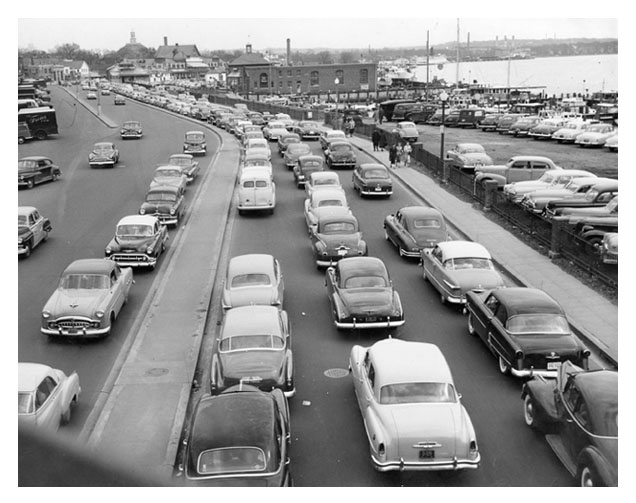Development of 1952, 1953, and 1954
District of Columbia
License Plates
|
|||||||||||||||||||||||||
 |
|||||||||||||||||||||||||
 |
|||||||||||||||||||||||||
 |
|||||||||||||||||||||||||
Introduction
It could be considered the height of irony, at least in the world of Washington, D.C. license plates, that some aspects of the 1952 and 1953 plates were planned simultaneously, for seldom have two consecutively-used plates had such drastically different characteristics. The material is the same, as are the numbering formats used, but everything else about these plates is dissimilar, leading some collectors to express surprise upon realizing that one replaced the other. Throughout most of the design process in early 1952, 1953 plates were expected to closely resemble the relatively small, yellow-and-black plates issued since 1948. That all changed, however, as the design process drew to a close, just as in the spring of 1953 did mid-1952 plans to issue red, white, and blue plates for 1954. The process of adding a slogan to D.C. plates for 1953, and why those plates weathered so poorly during their two years of service, are among the interesting stories about how plates of this three-year period were developed.
Compared to most of the states, the District of Columbia required a small number of vehicle plates annually during the 1950s. Although a few states had fewer residents and fewer cars, D.C. ranked among the jurisdictions in which a relatively small quantity of steel was required to produce a completely new set of plates, which at the time was typically done every year beginning late in the summer or during the fall so that they would be ready for distribution by the following February. Immediately after the United States became involved in the Korean War in mid-1950, with rationing of steel and aluminum for non-military uses still fresh in everyone's memory only five years after World War II, purchasing officials in both the private and public sector immediately became aware of the potential for another round of metal shortages. It is due to this awareness that D.C. officials began planning for plates to be issued in 1952 and 1953 in early 1951, several months before the '52 plates probably otherwise would have been considered. Because the DMV planned its 1952 and 1953 plates simultaneously, we will explain their history together, and we'll include a discussion of the 1954 registration year because of the drastic changes made to the original 1952 plans for plates of that year.
1952: One Plate or Two?
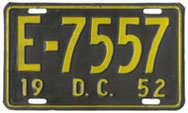 The question as to whether to provide each vehicle owner with one plate or two has been debated for as long as plates have been issued. No consensus has yet been reached: in 2009, one plate was issued per vehicle in 19 states whereas two were provided in the remaining 31, and in Canada only 4 of the ten provinces then distributed passenger car plates in pairs. Now that plates are replaced only periodically, the “singles vs. pairs” discussion is not debated so often. However, back when states had to set aside funds to procure or produce new plates on an annual basis, lawmakers routinely suggested that they be issued singly in order to conserve scarce public funds. On the other side of the argument, promoting pairs, has always been members of the law enforcement community, as well as companies engaged in the manufacture of plates or materials (metal and paint, or more recently reflective plastic sheeting) used in their production.
The question as to whether to provide each vehicle owner with one plate or two has been debated for as long as plates have been issued. No consensus has yet been reached: in 2009, one plate was issued per vehicle in 19 states whereas two were provided in the remaining 31, and in Canada only 4 of the ten provinces then distributed passenger car plates in pairs. Now that plates are replaced only periodically, the “singles vs. pairs” discussion is not debated so often. However, back when states had to set aside funds to procure or produce new plates on an annual basis, lawmakers routinely suggested that they be issued singly in order to conserve scarce public funds. On the other side of the argument, promoting pairs, has always been members of the law enforcement community, as well as companies engaged in the manufacture of plates or materials (metal and paint, or more recently reflective plastic sheeting) used in their production.
Jurisdictions that otherwise always issued license plates annually in pairs, such as the District of Columbia, customarily shifted to one-plate-per-vehicle systems, or issued windshield stickers or validating tabs in place of new plates, during wartime in order to conserve metal for military uses. World War II is, in fact, the reason that D.C. plates were issued singly in 1945 for the first time since 1918. As soon as the U.S. entered the Korean War in July 1950, officials in states in which plates were then being issued in pairs immediately began to consider shifting to a one-plate system, or using existing plates intended to last for only 12 months for multiple years, and this is exactly what happened in the District of Columbia.
Since its founding in 1933, the American Association of Motor Vehicles Administrators (AAMVA), located in Washington in the early 1950s (but since removed to Arlington, Va.), has facilitated communication and the sharing of best practices among officials of vehicle registration agencies throughout the United States. In a Jan. 12, 1951, memo entitled “License Plate Materials” sent to all of its members, AAMVA Executive Director L.S. Harris recommended that measures be taken to conserve metal. It would have been received by D.C. Director of Vehicles and Traffic George E. Keneipp not long before he presumably began thinking about arranging for the purchase of a new set of license plates for the 1952 registration year, for the black-on-yellow plates to be introduced in March 1951 had already been made. Mr. Harris wrote “Because of the officially declared national emergency, restrictions on the use of strategic materials are being added almost daily. The availability of materials for production of vehicle license plates is becoming less and less, and prices are going higher and higher. Several states are already experiencing difficulties in getting bids for steel for 1952 plates.” It is due to this memo and government-enforced limitations on non-military uses of certain commodities that caused so many states to not issue new plates for the 1952 registration year.
The Jan. 1951 AAMVA memo continues: “For states issuing annual plates, one plate is better than a revalidating tab or sticker. Twelve states are using only one plate for 1951. North Carolina has announced it will issue only one plate in 1952, if that much metal is available.” “In view of current conditions and anticipated shortages of plate material, I would respectfully recommend to all states the planning and preparation for use of only one plate for the 1952 registration year and until the ending of the emergency period.”
Shortly after he received the AAMVA memo, while yellow-on-black dated “1950” plates were nearing the end of their useful lives and shiny new black-on-yellow plates were awaiting their distribution, Mr. Keneipp contacted the city government's purchasing office to determine whether approximately 120 tons of 24-gauge steel might be procured in order to produce 1953 license plates, in pairs, for D.C. motorists. The order for steel needed to make 1952 plates had already been placed, and perhaps Mr. Keneipp would call for some modification to those plates, maybe a different numbering configuration or a larger size, if he learned that they would likely have to be used for more than one registration year. More likely, of course, is that he was considering making a recommendation to the commissioners that they direct him to issue only one plate for each 1952 registration in order to stockpile enough steel for the manufacture of 1953 plates. Roland M. Brennan, purchasing officer for the city government, wrote to Mr. Keneipp on March 14 about the availability of steel sufficient to produce new plates for both 1952 and 1953. “After talking with the local representative of the Bethlehem Steel Company, I have been assured that the sheet steel now on order for 1952 motor vehicle identification plates will be delivered during the late summer or early fall of this year. Should it be decided at the policy level to authorize the use of only one tag for the license year beginning April 1, 1952, there will be sufficient steel on hand for the license year beginning April 1, 1953.” “Steel,” wrote the purchasing officer, “at the present time is in very short supply, and according to all indications the supply will become tighter as the demand for defense increases.”
The D.C. commissioners appear to have been intent on issuing new plates in the coming years whereas their counterparts in many of the states had already decided to conserve metal by switching from pairs to singles, issue tabs in lieu of new plates, or at least make their plates smaller than in the past. D.C, in fact, went in the opposite direction: it issued new plates in pairs for both 1952 and 1953, and the 1953 plates were made in a larger format than the 1952s.
By late winter 1951 the National Production Authority (NPA) had already ordered a reduction in the number of automobiles that could be manufactured. The NPA, a federal agency originally within the Dept. of Commerce but moved to the Defense Production Administration in 1951, was created in Sept. 1950 primarily to ensure that needs of the civilian economy were adequately represented in defense mobilization efforts. Its Order M-1, as amended for steel, had “curtailed the amount of steel that may be sued for certain end products, and there is always the possibility that further restrictions may be imposed as defense needs mount,” wrote Mr. Brennan in his March 14 memo to Mr. Keneipp. “In view of the fact that steel is on the critical list of the NPA, and further in view of the restrictions now imposed on the use of steel, the possibility of obtaining 120 tons of steel sheets for delivery during the summer of early fall of 1952 [for the production of new plates for the 1953 registration year] appears to be highly questionable.” “Under the circumstances related above, and in the interest of conservation of a critical material needed for national defense and essential civilian requirements, as well as economy, I believe serious consideration should be given by the Commissioners to the issuance of only one motor vehicle identification plate for [1952 and 1953].”
As a direct result of the March 14 memo and earlier AAMVA communiqué, Mr. Keneipp decided to propose to the commissioners that only a single plate be made and issued for each vehicle for the 1952 registration year, leaving enough raw material for the later production of 1953 plates, which also would be issued singly. Within days he directed a subordinate to inform Major Robert J. Barrett, Superintendent of the Metropolitan Police Dept., of his decision. “The Director of Vehicles and Traffic is recommending to the Honorable Commissioners that a regulation be made for just one license plate on the rear of each automobile for 1952 and 1953. In this way, there is steel enough for two (2) years, instead of one (1) year,” wrote William J. Cunningham, Inspector in Charge of Traffic. “Mr. Keneipp wishes to have the Major and Superintendent informed of this recommendation, as, no doubt, the Commissioners will contact the Major for the Police Department's reaction to his recommendation.” To indicate the time-sensitivity of the issue, he ends his letter with this: “Occuquan must begin soon to make the license plates for next year.” The Lorton Reformatory, where D.C. plates were made at the time, was located near the Fairfax County, Va. town of Occuquan.
Indeed, it was only one day later that Mr. Keneipp made his formal recommendation to the commissioners about the 1952 plates. Although mention of 1953 plates is absent from the original recommendation, dated Tue., March 20, 1951, it was added to a later version. Included with the proposal for 1952 plates, which follows the format of earlier proposals and includes a list of letter prefixes to be used for plates of various types, was a copy of the aforementioned AAMVA and D.C. purchasing office documents. Mr. Keneipp summarized the situation directly in his recommendation, entitled “License Plates for 1952,” in this manner: “…it appears doubtful, in view of the international situation, as to whether additional steel will be available for the 1953 tags. Hence, should steel be unavailable for 1953 it would be necessary to issue tabs for the validation of 1952 tags, so that they would be valid for another year. From an administrative standpoint the issuance of tabs imposes a severe additional clerical burden on the Department of Vehicles and Traffic, and previous use of the tabs has been found very unsatisfactory for a number of reasons. We are of the opinion that it would be far better to issue one new plate each year rather than to resort to the use of tabs again.”
The next day, Major Barrett sent a report to the Commissioners, specifically to Hon. John Russell Young, President of the Commission, about Mr. Keneipp's proposal. “From a police standpoint,” wrote Major Barrett, “I would like to recommend that such a proposal be disapproved. The front tag of an automobile is very important in the detection of crime by members of the Metropolitan Police Department.” He proceeds to cite numerous examples of how the presence of front plates facilitates the identification of vehicles used in crimes, then offers his suggestion for the predicament that might be faced by the DMV in 1953 if 1952 plates were made in pairs. “In many states there are being used small tabs to be used with the old license plate for a new license year, and it is understood that has worked out very nicely. I would like to recommend that consideration be given to the use of small tabs in the District of Columbia, to be attached to the old license plate so that it may be used for more than one year.”
Their police superintendent's March 21 written opinion was apparently all the commissioners needed to convince them to direct that 1952 D.C. plates be made in pairs. The three commissioners, John Russell Young, F. Joseph Donohue, and Lt. Col. T.J. Hayes, III, met one week later, on Tue., March 27, to discuss the matter. Present at the meeting were Mr. Keneipp, Major Barrett, Mr. Brennan, and Mr. Donald Clemmer, director of the D.C. Dept. of Corrections, whose agency would produce the plates. Upon reviewing the relevant materials generated during the previous few weeks, the commissioners approved Mr. Keneipp's March 20 proposal for 1952 plates except that they directed that the plates be produced in pairs, not singly. Note that no decision was then made about whether plates (in pairs or as singles) or tabs would be issued for 1953, rather only that steel that might be saved in late 1951 by not making 1952 plates in pairs would in fact not be saved. Prior to the March 27 meeting it had been determined and announced, likely by Mr. Clemmer, that making 1952 plates in pairs would leave enough material to make a sufficient number of tabs for the 1953 registration year if not enough steel could be obtained for new plates.
A revised order for the production of 1952 plates, this one specifying that they be made in pairs, was prepared (presumably in advance of the commissioner's meeting) by Mr. Keneipp, and was signed by Mr. G.M. Thornett, the Board's secretary.
1953: Evolution of "A Most Attractive Tag"
 During most of the five-week period from late January through early March 1952, as planning for D.C.'s 1953 plates commenced, everyone involved in the process seems to have agreed that the plates would closely resemble 1951 plates then in use, with all characteristics being identical (except that the year designation would obviously be “1953,” not “1951.”) In other words, early plans called for yellow-on-black plates dated in the issuance-year (not expiration date) method used since 1948. Plates eventually issued, in a new size and color scheme, and emblazoned with the District's first plate slogan and the expiration date, do not appear to have been on anyone's mind at this early stage. Fortunately, a selection of documents preserved at the National Archives provides valuable information about the evolution of 1953 District of Columbia license plates.
During most of the five-week period from late January through early March 1952, as planning for D.C.'s 1953 plates commenced, everyone involved in the process seems to have agreed that the plates would closely resemble 1951 plates then in use, with all characteristics being identical (except that the year designation would obviously be “1953,” not “1951.”) In other words, early plans called for yellow-on-black plates dated in the issuance-year (not expiration date) method used since 1948. Plates eventually issued, in a new size and color scheme, and emblazoned with the District's first plate slogan and the expiration date, do not appear to have been on anyone's mind at this early stage. Fortunately, a selection of documents preserved at the National Archives provides valuable information about the evolution of 1953 District of Columbia license plates.
January 31-March 4, 1952: Availability of Steel Determined
By late 1951, several months before the planning of 1953 D.C. plates would have begun had the issue of steel rationing not been present, the AAMVA was already sharing with its member agencies information about the future availability of raw materials they would need to produce new license plates for 1953, whenever their particular registration years began. It also indicated that almost half of the 48 states were already issuing a single plate for each vehicle, or would do so soon. From late January into early March of 1952 a number of meetings were held, and a substantial amount of planning was undertaken, mostly on the subject of whether enough steel would be available to produce new plates at all.
On January 28, 1952, a letter was sent by Mr. Thomas Burke, Director of the National Production Authority, to the commissioners. Although we do not have a copy of this document, it apparently painted a gloomy picture of the prospect of the D.C. government being able to procure enough cold-rolled steel sheets to produce new license plates for 1953. Three days later the first recommendation for 1953 plates was prepared and forwarded to the commissioners. In it, Director of Vehicles and Traffic George Keneipp proposed that the 1952 plates (which had not yet been introduced) be used for a second year, validated with a tab, apparently in light of Mr. Burke's Jan. 28 letter, which the commissioners had forwarded to D.C. purchasing officer Roland Brennan. Presumably Mr. Keneipp drafted his proposal, calling for dated “53” strip tabs to be issued “so as to cover the numerals ‘52' which appear on such tags,” after receiving a synopsis of the Burke letter from Mr. Brennan. “Identification tags for the year ending March 31, 1954 shall be in the form of a metal strip, of a size to be determined by the Director, with black numerals on a canary yellow background,” wrote Mr. Keneipp in his proposal. “All strips shall be serially numbered, one number for each pair of tags, except motorcycle and trailer tags, each of which shall bear a separate number.”
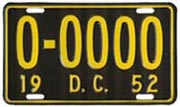 |
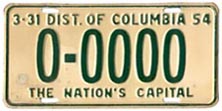 |
1952 and 1953 Sample Plates
|
|
It is unknown why a strip type of tab was given preference over the more prevalent corner-style tab, but perhaps dissatisfaction with the later type in years past prompted consideration of the longer style. In justifying his recommendation, Mr. Keneipp wrote “It is unlikely that sufficient steel will be available for the issuance of full-size license plates for all vehicles in 1953. Even if steel is available, in view of Government requests for steel conservation, it is desirable that the District cooperate in this movement and use no more steel this year than is necessary.” “It should be emphasized,” Mr. Keneipp continued, “that license plates cannot be used indefinitely as a basis for annually-issued tabs or clips. In climates such as the District's, the soft steel of the plate rusts quickly and the basic plate must be replaced at two-year intervals, at least, in order to maintain legibility.”
At about the same time that Mr. Keneipp was drafting his proposal for 1953 tabs, a meeting was held at the office of Mr. Burke at which the issue of steel availability was discussed. Present were Mr. Burke, Mr. Brennan, and a colleague of each gentleman. “At this conference the possible availability of cold-rolled steel sheets later in this year was discussed, as well as the use of single plates, [or] clips or tabs in lieu of two license plates,” wrote Mr. Brennan in a Feb. 7 report to the commissioners. “Mr. Burke had in his possession 3 or 4 letters from governors of states, indicating willingness to cooperate in the conservation program of the National Production Authority in the use of steel or aluminum for the production of 1953 vehicle license plates.”
By this time the NPA had decreed that states would be allowed to purchase metal for 1953 license plates in a quantity only up to 20% of what it historically had purchased to produce plates for an annual reissuance. Note that because we do not have a copy of the NPA's “20% basis plan,” our description of it is based upon references in D.C. government documents cited. The director of the AAMVA discussed this limitation in a Feb. 5 letter to its member agencies: “Since the N.P.A. will allocate only 20% of the figure developed as a basis, it follows that some states may be materially restricted. As a result, almost all states will have to revalidate plates now on vehicles by using tabs, clips, inserts, etc. Some states, however, at the present time have on hand, as a result of conservation, almost enough metal to make full-size 1953 plates for each registered vehicle. In such cases, if the amount of metal required hereafter does not exceed the 20% allocation, it is permissible for the state to make full-size plates. [The] N.P.A. restriction does not apply to the type of marker to be produced – it only applies to the amount of metal to be allocated hereafter for 1953 markers. In other words, you can make any type marker out of the metal you have on hand plus the amount that N.P.A. will allocate on the 20% basis.”
On Feb. 6, another meeting about the steel situation was held. Joining Mr. Brennan at his office were Mr. Keneipp, as well as “Inspector Agnew of the Police Department, the Executive Assistance to the Director of Corrections, the Superintendent of Industries and the Procurement Officer, Department of Corrections, and the priorities and Allocation Specialist of this office” according to the host's Feb. 7 account of the meeting to the commissioners. After the AAMVA memo issued the previous day was presented by Mr. Keneipp, exactly how much metal would be available for 1953 was discussed. Of this discourse, Mr. Brennan wrote “Normally, the District purchases approximately 120 tons of 24-gauge cold-rolled steel sheets for each year's requirement of two plates [per vehicle.] Delivery is usually made during the second or third quarter of the calendar year. The Superintendent of Industries now has in inventory about 37.5 tons of sheet steel. On the basis of [the passage of the Feb. 5 AAMVA memo quoted in the previous paragraph], the District would be able to obtain approximately 24 additional tons of steel, 20% of the amount obtained during the base period, which would give us 61.5 tons for our 1953 use.”
With 61.5 tons of steel available for the 1953 registration year, Mr. Brennan indicated that the two viable options were to produce either a single new plate for each privately-owned vehicle registered for and throughout 1953; or tabs to validate all 1952 plates for which the corresponding registrations were renewed for 1953, along with new plates, made in pairs and with tabs, “for new registrations, replacements, etc., in 1953.” Mr. Brennan's recommendation was the that first option, new plates issued singly, be chosen. Among reasons he cited were that the use of single plates for 1953 “would overcome administrative difficulty similar to that encountered the last time tabs were used, and would save the expense of setting up a special tab file in the Department of Vehicles and Traffic,” as well as that issuing single plates “would afford a trial period of a year for the determination of the effect, if any, on police law enforcement, and possibly lead to future economy.”
Prospects for the procurement of sufficient metal to produce new 1953 license plates, in pairs, improved in mid-February 1952. We don't know exactly why this occurred, but the military situation on the Korean Peninsula had stabilized in May 1951 with the declaration of a stalemate that lasted until the armistice of 1953. Although fighting continued, little territory was exchanged, the front along the 38 th parallel (what would become the demilitarized zone) held, and most of the principal battles of the stalemate had yet to occur. Probably it was progress in the war coupled with changes in world markets that led to the opinion that restrictions on commodities would be eased later in the year, possibly in time for U.S. registration agencies to obtain materials that they needed to have new license plates manufactured.
This noteworthy change was documented in a Feb. 18 memo to the commissioners from Mr. Brennan, who wrote “Since my memorandum of February 7, 1952, notice has been received from the N.P.A. that for the time being, all states and the District of Columbia may apply for an allocation of steel for full plates for the license year 1953. [However,] I am confused by the conditional statement of the N.P.A. ‘for the time being.' Apparently, there still appears to be an element of uncertainty as to whether the steel will be available for use in the third quarter of 1952. If the statement reported to have been made by Munitions Board Chairman John D. Small proves to be true, viz: ‘The military take of metals will start easing off after July 1, and civilians should get a greater share of available steel and aluminum in the last half of the year,' it should offer some encouragement.” After reiterating his recommendation that 1953 plates be produced singly due to the “marked economy that would result,” he appropriately left the decision to his superiors. “If the commissioners decide to continue the use of two license plates for the license year 1953, this office would like to know as soon as possible so that our application [for additional steel] may be filed by February 29, 1952.”
The commissioners apparently (and not surprisingly) responded in the affirmative, for two days later Mr. Keneipp issued a revision to his Jan. 31 proposal, this one specifying that the planned black-on-yellow, 6”x10” 1953 plates be made in pairs (except, as always, for motorcycle and trailer plates). It was approved by the commissioners on March 4, apparently ending the decision-making process about 1953 District of Columbia license plates. Or so it seemed.
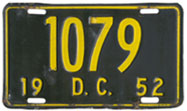 |
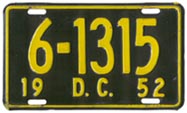 |
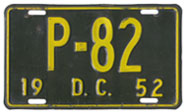 |
 |
 |
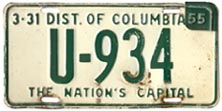 |
1952 and 1953/54 Passenger Car Plates
|
||
April 23-May 1, 1952: "Final" Design is Changed Dramatically
Unfortunately we do not have much documentary evidence about how and why the design of 1953 D.C license plates was changed so dramatically, and apparently in such a short period of time. To summarize, in late April 1952 the design was changed completely, from a 6”x10”, black-on-yellow, sloganless plate marked “1953,” to a 6”x12”, green-on-white plate with a slogan and marked with the expiration date, “3-31-54.”
The color change, first proposed by Mr. Keneipp in an April 23, 1952, proposal to the commissioners, was suggested for two reasons. First, since early March it had been learned that 1953 Maryland plates, to be used during the same period as D.C.'s 1953 plates, were planned (or perhaps were already being produced) in yellow on black, which, according to Mr. Keneipp, “would be in some conflict” with the black-on-yellow planned for D.C. This appears to be a weak argument simply because the D.C. and Maryland plates would indeed have been opposite colors. Furthermore, their sizes, layouts, and numbering configurations were completely different, so it is doubtful that plates from one jurisdiction would ever be confused with those from the other. In fact, it appears that D.C. residents were simply tired of the black-and-yellow (and a few black-on-orange) combinations they had used since 1936. “A large number of persons in the District of Columbia have complained frequently to the Director of Vehicles and Traffic that a color combination other than the customary yellow and black would be much welcomed by the motoring public here,” wrote Mr. Keneipp. It is unknown whether it is merely a coincidence that the last time D.C. plates were not some combination of black and yellow or orange, they were green on white. However, setting aside the 1935 plates, Mr. Keneipp enthused in his proposal that “A sample of the proposed green and white color combination has been submitted to the Engineer Commissioner, and it is thought that the Board of Commissioners will agree that [it] is a most attractive tag.”
The engineer commissioner, Mr. Bernard L. Robinson, presented the green-on-white prototype to his fellow commissioners at their meeting on April 29. The appearance of this plate was not documented, so we do not know whether it was of the 6”x10” format used since 1948 or the new 6”x12” format approved within the following few days. In a memorandum for the minutes of this meeting is where we first find a reference to a proposed design in the colors of red, white, and blue, which soon became the approved design for 1954 but ultimately was never issued. Later documents indicate that it was a white plate with the registration number painted in blue and remaining embossed features in red. Whether a prototype of this alternative was shown at the meeting is unknown, but it appears to not have been. Nevertheless, commissioners Young and Donohue expressed a preference for the tri-color plate, even knowing that its production costs would be higher than traditional two-color plates. Both believed, however, that it would be worth the difference in cost. No decision was made at this meeting about the 1953 plate colors because Mr. Robinson requested additional time to review the red-and-blue-on-white plate.
On Thursday, May 1, 1952, almost two months after they had given their approval to a traditional, unimaginative black-on-yellow design for 1953, the commissioners met to discuss and decide upon the design of 1953 and 1954 District of Columbia license plates. Present at the meeting with the commissioners were Mr. Keneipp; Mr. Brennan; Major Robert V. Murray, Major and Superintendent of the Metropolitan Police Dept.; Mr. Donald Clemmer, Director of the D.C. Dep. of Corrections; and Mr. William C. Meade, Superintendent of Industries at Lorton Reformatory, and his assistant, Mr. Henry M. Lindsey, who together would be responsible for production of the plates.
We have no detailed report of what must have been an interesting meeting. The outcome, however, is clearly documented in an order in which D.C. plates for 1953 and 1954 are described. They were to be made in a new 6”x12” format, issued in pairs, and be green on white for 1953 and red and blue on white for 1954. Plates of both years were to have “3-31” displayed in the upper left corner, the two-digit year designation in the upper right corner, “DIST. of COL.” at the top center, and “ THE NATION'S CAPITAL” centered at the bottom. The rim was to be debossed. Motorcycle plates of each year were to be made in the same color combinations as full-size plates.
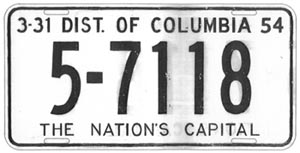 With this seemingly final decision, Mr. Meade and Mr. Lindsey apparently turned their attention to preparing to produce the plates. What they learned during May caused them to return to Mr. Keneipp, and he to the commissioners, in early June with two minor design modifications that resulted in the 1953 plates with which we are familiar today. The rim was changed from being debossed to the more traditional embossed style, and the city name was lengthened to “DIST. OF COLUMBIA.” About his proposal, Mr. Keneipp wrote “The effect of approval of this order will be that the 1953 license tags will have an embossed rim, which is far superior in appearance to the debossed rim, and that the words “Dist. of Columbia” will replace the words “Dist. of Col.” in the top center of the plates. When the previous order was submitted, it was not believed that the Lorton Reformatory could manufacture the larger tag with the increased copy on sheet steel with an embossed rim. A debossed rim was therefore proposed. Also, it was believed that it would be impossible to spell out the word “Columbia” in full because of the lack of sufficient room. However, when the Reformatory prepared the attached final sketch of the tag, it was found that an embossed rim with dies reading “Dist. of Columbia” could be utilized in the manufacture of the new tags.” These modification were approved by the commissioners on June 5, marking the true end of the design process of 1953 Washington, D.C. plates.
With this seemingly final decision, Mr. Meade and Mr. Lindsey apparently turned their attention to preparing to produce the plates. What they learned during May caused them to return to Mr. Keneipp, and he to the commissioners, in early June with two minor design modifications that resulted in the 1953 plates with which we are familiar today. The rim was changed from being debossed to the more traditional embossed style, and the city name was lengthened to “DIST. OF COLUMBIA.” About his proposal, Mr. Keneipp wrote “The effect of approval of this order will be that the 1953 license tags will have an embossed rim, which is far superior in appearance to the debossed rim, and that the words “Dist. of Columbia” will replace the words “Dist. of Col.” in the top center of the plates. When the previous order was submitted, it was not believed that the Lorton Reformatory could manufacture the larger tag with the increased copy on sheet steel with an embossed rim. A debossed rim was therefore proposed. Also, it was believed that it would be impossible to spell out the word “Columbia” in full because of the lack of sufficient room. However, when the Reformatory prepared the attached final sketch of the tag, it was found that an embossed rim with dies reading “Dist. of Columbia” could be utilized in the manufacture of the new tags.” These modification were approved by the commissioners on June 5, marking the true end of the design process of 1953 Washington, D.C. plates.
It is curious that the addition of a slogan to D.C. license plates, and the adoption of a 6”x12” format that facilitated that change, are not mentioned in any documents about the design process until the May 1, 1952, order in which the final design is specified. Presumably these critical characteristics were discussed and debated leading up to the May 1 meeting, but we have no record of such discourse. Fortunately, we do have two pieces of fall 1950 correspondence that indicate that the slogan may have been the idea of Mrs. Ethel C. Bailey, a resident of N.W. Washington. On Sept. 22, 1950, she typed this note to the commissioners: “Gentlemen: I am writing to advocate a change in the District of Columbia license plates by the addition of the descriptive phrase ‘The Nation's Capital.' I think the tags should also bear the words ‘Washington, D.C.' instead of just ‘D.C.' It has been our experience in traveling only a few hundred miles from Washington that many people have no idea what ‘D.C.' stands for, and we have overheard a number of strange and peculiar explanations. This suggestion is not prompted alone by pride in our beautiful city but by the feeling that everyone in the U.S.A. should at least know the name of the capital of his country – there are many who don't!”
The only record that we have of any official's opinion of Mrs. Bailey's suggestion is an Oct. 6, 1950, memo from Director of Vehicles and Traffic George Keneipp to the secretary of the Board of Commissioners. He was cool to the idea, writing that “We, too, have great pride in our beautiful city, but we are also cognizant of the fact that the prime purpose to be served by a license plate is to provide for ready and quick identification of a vehicle. Any extra wording or lettering that detracts from quick observation of the tag number and the jurisdiction in which the vehicle is registered could result in serious consequences.” Sixty years later, D.C. plates are still relatively free from superfluous adornment, but Mr. Keneipp would undoubtedly cringe were he able to see some of the graphic plates being issued elsewhere. In fact, many of his modern counterparts in DMV and law enforcement service have lamented the relative illegibility of some of today's graphic license plates.
One could argue that another record of an official opinion about the Bailey slogan is the 1953 plates themselves. Mrs. Bailey's suggestions were received too late to affect the 1951 plates, but they could have been adopted for the 1952 plates. They were not, but only a year later D.C. plates were enlarged and the slogan included. Was the plate size changed solely to accommodate the slogan and expanded city name, or were these features a by-product of the new size made for some other reason? Just as they embraced the idea of a tri-color plate for 1954 (which was later scuttled), could the commissioners have also reacted so favorably to the proposed slogan that they ordered that plates be made larger, this in spite of questions about the availability of enough steel just to make plates in the standard (since 1948) 6”x10” format? By 1952, the effort to adopt a standard size for all U.S. license plates (except small plates made for use on motorcycles and certain other vehicles) was underway, led by the AAMVA in concert with automobile manufacturers, and a committee to study the issue named at the group's 1952 convention included Mr. Keneipp among its members. Although it was not until October 1953 that the committee made its final recommendation of a standard 6”x12” format, which was unanimously accepted, it is entirely possible that Mr. Keneipp knew enough about the committee's findings to effect the lengthening of 1953 D.C. plates by two inches between March 4 and May 1, 1952.
In his Oct. 1950 memo in which he responded to Mrs. Bailey's suggestions for changes to D.C. plates, and specifically about the inclusion of “THE NATION'S CAPITAL” along with the jurisdiction name and issuance year designation or expiration date, Mr. Keneipp wrote that “To put all this wording on each tag would require a larger tag than the present one, 6”x10”. The plates would cost considerably more than they do now and would require more steel, a commodity which is in short supply. Furthermore, most of this lettering would have to be in rather small size letters, and it has been our experience that the Lorton Reformatory is unable to manufacture dyes [sic] with small letters which do not fracture the steel and cause rapid deterioration of the plates.”
About replacing “D.C.” with “WASHINGTON, D.C.,” he wrote that “It has never been deemed desirable to use ‘Washington, D.C.' on District tags because of the confusion which would be created with tags issued by the State of Washington. The familiarity of names would undoubtedly pose a serious handicap to the agencies of enforcement throughout the country because of the misunderstanding which would be sure to arise.”
We have no documentation that directly links Ms. Bailey's Sept. 1950 note to the inclusion of her suggested slogan on plates manufactured during the second half of 1952. Although someone may have suggested the slogan before her, it seems likely that it was Ethel Bailey's idea that led to the adoption of a slogan that remained on D.C. plates issued for all but four of the next 32 years.
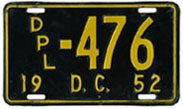 |
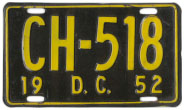 |
 |
 |
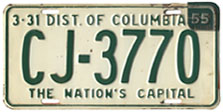 |
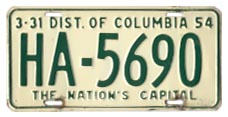 |
1952 and 1953/54 Diplomatic, Commercial (Truck), and Hire (Taxi) Plates
|
||
The Quintessential “Bad-Paint Year”
Exactly what prompted a minor controversy in early 1954, as the reuse of 1953 D.C. plates for a second year was announced, is unknown, but extant documents in which officials responded to criticism about the relatively poor condition of some of the plates after a year of use provide interesting details about why the plates did in fact not hold up well, resulting in their being unusually difficult for collectors to find in nice condition today.
Although we have a Feb. 17, 1954, memo written by Mr. Donald Clemmer, Director of the D.C. Dept. of Corrections, to the commissioners about the condition of 1953 auto plates produced by his department, we don't know what prompted its preparation. Presumably a newspaper writer or some public figure criticized the decision, likely then just announced, to use the green-on-white 1953 plates for a second registration year. In the introduction to his memo, Mr. Clemmer writes that his department “is concerned and perturbed over the fact that criticism has come to us in reference to the appearance of the 1953 tag.” The reason that the 1953 plates did not wear particularly well, a continual source of frustration for license plate collectors today, is, according to Mr. Clemmer, simply “that we manufactured the 1953 tags for a period of only one year. We were given no indication at the time of their processing that the tags might have to serve for a two-year period. If we had had any suggestion that the plates would be used for two years, we would have processed them with a rust-resistant prime coating of iron oxide in their manufacture, which is the usual procedure.” “This department takes the position, therefore, that it cannot be wholly blamed because of the appearance of the tags,” he wrote.
Regarding the decision to issue for tabs for 1954, which is discussed below, Mr. Clemmer wrote that “Whereas perhaps some relatively small savings of around $15,000 has been contemplated in using one-year tags for two years, when this was proposed to us we strongly advised against it on March 24, 1953, in a letter to the Director of Vehicles and Traffic. We also informally advised against using white paint as a background.” During 1953, he writes, “There was no shortage of steel, and we could have, for 1954, produced a handsome and sturdy tag just as we have in other years…” The director continued by making recommendations for future plates, including switching to heavier, 20-gauge steel as opposed to the 24-gauge material used for 1953.
In order to accommodate motorists whose 1953 plates were in poor condition after a single year of use, the commissioners announced in late March that the Dept. of Motor Vehicles would provide a new set of plates (and tabs), without charge, to anyone that wished to call for them at its office during April or May 1954. This is among the reasons that the supply of plates in the standard number sequences, 1-1000 through 9-9999 and certain letters followed by numbers up to 9999, was exhausted during the 1954 registration year. As a result, a relatively small quantity of plates with a registration number comprised of two letters followed by up to three numbers (beginning at AA-1) was issued.
1954: Demise of “A Handsome and Sturdy Tag”
 The commissioners met on May 1, 1952, to decide upon the design of plates to be issued during March of 1953 and 1954 (as discussed above). Their decision for the 1954 registration year called for plates in the exactly same design as 1953 plates as they were eventually issued, but to change the colors. Whereas 1953 plates are green on a white background, the 1954 plates as originally approved were to have a blue registration number on a white background, but all other embossed features (the city name, slogan, expiration date and border), were to be red, resulting in a tri-color plate similar to U.S. Government plates recently made at Lorton (we believe for early 1952 issuance, although this has not been confirmed) and already in use. The effect of using red on only the border of the tri-color federal plates was minimized because the border was first painted dark blue, so the contrasting red is difficult to see. Presumably D.C. plates would have been made in the same fashion, but perhaps when the subdued effect of the red-over-blue treatment was observed, the process would have been changed so that areas to appear in red were not first covered in blue paint.
The commissioners met on May 1, 1952, to decide upon the design of plates to be issued during March of 1953 and 1954 (as discussed above). Their decision for the 1954 registration year called for plates in the exactly same design as 1953 plates as they were eventually issued, but to change the colors. Whereas 1953 plates are green on a white background, the 1954 plates as originally approved were to have a blue registration number on a white background, but all other embossed features (the city name, slogan, expiration date and border), were to be red, resulting in a tri-color plate similar to U.S. Government plates recently made at Lorton (we believe for early 1952 issuance, although this has not been confirmed) and already in use. The effect of using red on only the border of the tri-color federal plates was minimized because the border was first painted dark blue, so the contrasting red is difficult to see. Presumably D.C. plates would have been made in the same fashion, but perhaps when the subdued effect of the red-over-blue treatment was observed, the process would have been changed so that areas to appear in red were not first covered in blue paint.
Extant documentation about the development of 1954 District of Columbia license plates is not explicit as to why tabs were issued and plans for red-and-blue-on-white plates abandoned. However, cost and budget limitations, not metal conservation or any other issue, appears to have been at the heart of the decision.
The fist cost-saving measure adopted in early 1953, as plans to produce the tri-color 1954 plates were being made, was decided by the commissioners at a Board meeting held on March 5. It was then that the city leaders voted to rescind their order of ten months earlier that called for production of the colorful, non-traditional plates that they liked so much. It is likely that they still would have preferred the red-and-blue-on-white plates, but that they could not justify the added production costs. Instead, “The commissioners approved for 1954 a green background with white numerals and lettering in accordance with a sample exhibited to them by Mr. George E. Keneipp,” according to notes of the meeting. “The Commissioners directed that the item for automobile tags in the District budget for the fiscal year beginning July 1, 1953, be reduced by $20,000 because of the difference in price of the red, white and blue tag as against the green and white tag.”
Carrying out the commissioner's March 5 decision, on March 6 Mr. Keneipp issued an order to the effect that 1954 D.C. plates would be white on green, and that the design be changed slightly such that the expiration date be indicated with the expiration date “3-31” embossed in the lower left corner, and the year designation “55” in the lower right corner, with “DIST. OF COLUMBIA” centered at the bottom and “THE NATION'S CAPITAL” across the top.
At a meeting on March 17, 1953, Commissioner F. Joseph Donohue suggested that the slogan be changed to “FEDERAL CITY.” Because no further mention of this proposal has been found and because it was not implemented, presumably it was never the subject of a binding vote.
 |
 |
1952 and 1953 Motorcycle Plates |
|
| Note that motorcycle plates continued to be marked with the year of issuance, not the expiration date, for 1953. | |
Pairs vs. Single Plates Revisited
Developments of mid-March through mid-April are somewhat difficult to understand because communication during this period was often conducted by telephone. These conversations are referenced but not fully described in official writings in which important decisions are documented. For example, a March 16 memo prepared by purchasing officer Roland Brennan about the cost of various alternatives for the 1954 registration year was almost certainly prepared in response to preliminary conversations about what could be done to save money in fiscal 1953, but exactly what options officials thought the commissioners would consider is unknown. In his memo, addressed to Mr. Schuyler Lowe, Director of General Administration, Mr. Brennan reiterates his work of the previous year as to why it would be in the city government's best interest to adopt a one-plate-per-vehicle system as soon as possible. He proceeds to indicate that, just as the 1953 plates were being distributed, the Dept. of Corrections had sold to the Dept. of Vehicles and Traffic 182,246 pairs of the green-on-white plates for $.185 per pair, for a total cost (including labor) of $33,715.51. Details of material costs associated with the production of the initial supply of 1953 plates are as follows:
| Steel | $11,527.06 |
| Background enamel and numeral coating | 3,194.62 |
| Wax paper | 120.45 |
| Crating lumber | 109.35 |
| Envelopes | 2,365.55 |
$17,317.03 |
He then estimates that the total cost to the DMV for 200,000 single 1954 plates would be $23,000, including materials listed below. Further assumptions are that the cost per plate would be $.115, and that 45,000 plates would be mailed during the reissuance process.
| Steel | $6,325 |
|
| Background enamel and numeral coating | 1,752 |
|
| Crating lumber | 60 |
|
| Envelopes | 2,500 |
|
| sub-total | 10,637 |
|
| Postage for 45,000 plates (at $.15 each) | 6,750 |
|
| total of materials and postage | $17,387 |
|
Issuing only one plate per vehicle for 1954, wrote Mr. Brennan, should “be considered in the interest of saving approximately $9,000 in material costs and postage, or about $11,000 in the cost of tags to the Department of Vehicles and Traffic, including labor costs.” Regarding the familiar argument made by law enforcement officials of the benefit of a front plate being displayed on each registered vehicle, Mr. Brennan brought to Mr. Lowe's attention that even if D.C. motorists did each receive two plates, police officers would still have to handle cars without a front plate. “The State of Maryland is using only one tag this year,” he wrote, “and since approximately 100,000 Maryland motor vehicles enter and leave the District of Columbia every work day, it would seem that the objection of the Police Department to one tag on District motor vehicles should be mitigated by reason of the fact that the Department will have experience hereafter with one-tag motor vehicles of Maryland.” Indeed, Maryland plates issued in 1953 (marked "54") and 1954 (marked "55") were issued singly, but most plates before, and all since, have been issued in pairs.
Also, in mid-March, Mr. Keneipp spoke and corresponded with Mr. L.S. Harris, executive director of the AAMVA, regarding the one-plate-per-vehicle issue. Mr. Harris sent to Mr. Keneipp a detailed survey (as of December 1952) of the number of plates per vehicle, registration year, plate characteristics, and related data for all 48 states, all of the Canadian provinces, and Canal Zone. In separate April 2 and 3 memos to Mr. Lowe, Mr. Keneipp summarized their options for the 1954 registration year:
| 1. | Two plates per vehicle (as presently authorized by the Commissioners): | |
| - 220,000 pairs, size 6" x 12," at $.18 per pair - $39,000 | ||
| (Funds are included in 1954 estimates for this purpose.) | ||
| - Present mailing costs amount to $.20 per pair, and in 1953, through April 1, | ||
| 64,914 pairs were mailed at a cost of approximately $13,000 | ||
- Total for manufacturing and mailing of two plates - $52,600 |
||
| 2. | One plate per vehicle: | |
| - 220,000 at $.115 - $25,300 | ||
| - Postage for same number as mailed in 1953, approximately $12,000 | ||
| - Total cost for manufacturing and mailing of one plate - $37,000 | ||
| 3. | Tabs issued in pairs: | |
| - 220,000 pairs of tabs at $.065 per pair - $14,300 | ||
| - 90,000 pairs of 6" x 12" license plates (for newcomers to the city and new | ||
| owners who would require both plates and tabs) at $.18 - $16,200 | ||
| - Sub-total: cost for tags and tabs - $30,500 | ||
| - Postage for 70,000 sets of tabs at $.09 - $6,300 | ||
| - Total cost for manufacturing and mailing of pairs of tabs and tags - $36,800 | ||
| 4. | Tabs issued singly: | |
| - 220,000 single tabs at $.04 - $8,800 | ||
| - 90,000 single plates at $.115 - $10,350 | ||
| - Postage for 70,000 single tabs at $.06 each - $4,200 | ||
| - Total cost for manufacturing and mailing single tabs and tags - $23,350 | ||
In an April 6 writing to Commissioner Louis W. Prentiss, the engineer then presently on the Board, Mr. Lowe summarized his recent communications with Mr. Keneipp and Mr. Brennan. He indicated that Major Robert V. Murray of the Metropolitan Police Department was opposed to the display of only a single license plate on each vehcile, and that “Mr. Keneipp thinks the best immediate measure is to revalidate the 1953 tags for use in 1954, by means of small metal tabs to be attached to each plate.” Mr. Lowe closed his letter by urging the commissioners to decide soon what would be done for the 1954 registration year “in view of the fact that the Department of Corrections must soon start manufacturing 1954 plates.”
Three days later, the commissioners did indeed approve the issuance of white-on-green validation tabs, issued in pairs and serially numbered, to revalidate 1953 license plates for the 1954 registration year. They specified that the tabs include the "55" year designation but left the size (and presumably the overall design) up to Mr. Keneipp, who undoubtedly conferred with representatives of the Dept. of Corrections as to how the tabs would actually appear and be affixed to plates that had not been made with slots to accept tabs of the style then in use in Maryland, among other states. What they devised is a tab unique in the U.S., one that is displayed in the corner of the plate separate from the nearest bolt hole and not utilizing slots in the plate. This design, with the portion of the tab through which a bolt is used to secure it to the plate being visible only on the back of the plate, was likely used so as to not obscure a portion of the city name or slogan.

|
This page last updated on December 31, 2017 |
 |
|
copyright 2006-2018 Eastern Seaboard Press Information and images on this Web site may not be copied or reproduced in any manner without consent of the owner. For information, send an e-mail to admin@DCplates.net |















